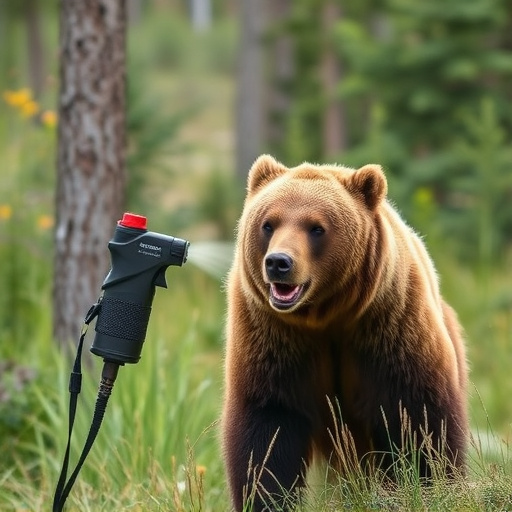Understanding bear behavior is crucial when assessing bear spray's effectiveness against charging grizzlies, which can be unpredictable and aggressive due to defense or cub protection instincts. Bear spray, a potent self-defense tool, disrupts bears' sensory organs with capsaicin, allowing humans to escape safely. While not 100% guaranteed, it has proven successful in many cases, especially against cornered grizzlies. Proper usage, including direct application to sensitive areas and following manufacturer instructions, is key for success; additionally, noise making and trail awareness are vital for preventing dangerous encounters.
In the great outdoors, encounters with bears can range from thrilling to terrifying. One common question among adventurers: does bear spray truly work against charging grizzlies? This article delves into the science behind bear spray and its effectiveness in deterring aggressive behavior, particularly focusing on grizzly bears. We explore the nuances of bear behavior, how bear spray operates, and provide best practices for using this tool responsibly in potential high-risk situations, offering insights crucial for outdoor enthusiasts navigating bear country.
- Understanding Bear Behavior: When and Why They Charge
- What is Bear Spray and How Does it Work?
- Effectiveness of Bear Spray Against Charging Grizzlies
- Best Practices for Using Bear Spray in the Wild
Understanding Bear Behavior: When and Why They Charge
Understanding bear behavior is crucial when assessing the effectiveness of bear spray against charging bears. Bears, especially grizzlies, are wild animals with powerful instincts that can make them unpredictable and aggressive. They have a keen sense of smell and hearing, which they use to detect potential threats or food sources from miles away. When a bear encounters what it perceives as a threat, its natural reaction is to charge, often as a defensive mechanism to protect itself or its cubs.
Charging behavior can vary depending on the species and the situation. For example, a grizzly bear might charge when it feels cornered or threatened by a group of hikers. In such cases, bear spray has proven to be an effective deterrent. When used properly, bear spray creates a barrier of capsaicin (the active ingredient), which temporarily blinds and disorients the bear, giving you precious time to retreat safely. However, when comparing bear spray to other methods, like hazing techniques or physical barriers, it’s important to note that its effectiveness depends on factors such as the bear’s mood, distance, and individual temperament—no single method is a universal solution in Bear Spray Vs Charging Grizzly encounters.
What is Bear Spray and How Does it Work?
Bear spray, also known as bear repellent, is a specialized pepper spray designed to deter and protect against aggressive bears. When faced with a charging grizzly or black bear, this non-lethal self-defense tool can be a life-saving measure. It works by delivering a powerful stream of capsaicin, the active ingredient found in chili peppers, into the bear’s eyes and face. This irritates the bear’s sensitive sensory organs, causing it to momentarily stop and retreat, providing the user with precious time to escape or seek shelter.
Unlike traditional pepper spray used for human self-defense, bear spray is formulated to be more potent and project a wider range of particles. This ensures maximum coverage when spraying at close range, which is crucial when dealing with an enraged bear. When used correctly, it can effectively stop a charging bear in its tracks, giving the user a chance to assess the situation and make a safe escape.
Effectiveness of Bear Spray Against Charging Grizzlies
Bear spray has long been touted as an effective deterrent against charging grizzlies, but just how reliable is this method? When used correctly, bear spray can significantly reduce the risk of injury or death in encounters with aggressive bears. The key to its effectiveness lies in the ability of the spray to create a barrier between the victim and the bear, disrupting the bear’s sensory perception and causing it to pause and reassess its attack.
In comparison to other methods, such as noise makers or physical barriers, bear spray has shown promise in studies and real-world scenarios. While no deterrent is 100% effective against determined charges, bear spray can provide crucial seconds for a person to escape or prepare for self-defense. However, the success of bear spray depends on factors like the proximity of the bear, wind direction, and the skill of the user in deploying the spray effectively.
Best Practices for Using Bear Spray in the Wild
When faced with a charging bear, quick thinking and proper usage of bear spray can be your best defense. It’s crucial to remember that bear spray is most effective when used strategically against a bear’s face and eyes, which are sensitive areas. Unlike Bear Spray vs Charging Grizzly encounters, where instinct might suggest aiming for the bear’s body, direct and focused application is key to incapacitating the bear quickly.
For optimal results, ensure your bear spray is properly licensed, checked for expiration, and used in accordance with manufacturer instructions. Practice targeting techniques before venturing into grizzly territory, and always keep it within easy reach. Remember, using bear spray as a last resort increases survival chances during an encounter, but prevention through noise making and careful trail awareness remains paramount.
Bear spray has proven to be an effective deterrent against charging grizzlies, offering a crucial tool for adventurers and outdoor enthusiasts navigating bear country. While no single method guarantees complete protection, understanding bear behavior and employing best practices for using bear spray can significantly enhance safety in potentially dangerous encounters. When used correctly, bear spray presents a powerful option for deterring aggressive bears, providing vital seconds to escape or re-evaluate one’s position. By staying informed about bear spray effectiveness and following proper usage guidelines, individuals can better protect themselves during outdoor activities in areas inhabited by these magnificent creatures.
